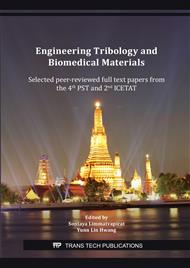[1]
S.O. Akintoye, M.S. Greenberg, Recurrent aphthous stomatitis, Dental clinics of North America. 58(2) (2014) 281-297.
DOI: 10.1016/j.cden.2013.12.002
Google Scholar
[2]
M.S. Greenberg, A. Pinto, Etiology and management of recurrent aphthous stomatitis, Current Infectious Disease Reports. 5(3) (2003) 194-198.
DOI: 10.1007/s11908-003-0073-z
Google Scholar
[3]
S.S. Natah, Y.T. Konttinen, N.S. Enattah, N. Ashammakhi, K.A. Sharkey, R. Häyrinen-Immonen, Recurrent aphthous ulcers today: A review of the growing knowledge, International Journal of Oral and Maxillofacial Surgery. 33(3) (2004) 221-234.
DOI: 10.1006/ijom.2002.0446
Google Scholar
[4]
S. Krisdapong, A. Sheiham, G. Tsakos, Impacts of recurrent aphthous stomatitis on quality of life of 12- and 15-year-old Thai children, Quality of Life Research. 21(1) (2012) 71-76.
DOI: 10.1007/s11136-011-9925-4
Google Scholar
[5]
C. Scully, S. Porter, Oral mucosal disease: Recurrent aphthous stomatitis, British Journal of Oral and Maxillofacial Surgery. 46(3) (2008) 198-206.
DOI: 10.1016/j.bjoms.2007.07.201
Google Scholar
[6]
M. Chavan, H. Jain, N. Diwan, S. Khedkar, A. Shete, S. Durkar, Recurrent aphthous stomatitis: A review, J. Oral Pathol. Med. 41(8) (2012) 577-583.
DOI: 10.1111/j.1600-0714.2012.01134.x
Google Scholar
[7]
C.-L. Li, H.-L. Huang, W.-C. Wang, H. Hua, Efficacy and safety of topical herbal medicine treatment on recurrent aphthous stomatitis: a systemic review, Drug design, development and therapy. 10 (2015) 107-115.
DOI: 10.2147/dddt.s96589
Google Scholar
[8]
N. Salamat-Miller, M. Chittchang, T.P. Johnston, The use of mucoadhesive polymers in buccal drug delivery, Advanced Drug Delivery Reviews. 57(11) (2005) 1666-1691.
DOI: 10.1016/j.addr.2005.07.003
Google Scholar
[9]
S. Tewtrakul, S. Subhadhirasakul, Effects of compounds from Kaempferia parviflora on nitric oxide, prostaglandin E2 and tumor necrosis factor-alpha productions in RAW264.7 macrophage cells, Journal of Ethnopharmacology. 120(1) (2008) 81-84.
DOI: 10.1016/j.jep.2008.07.033
Google Scholar
[10]
D. Chen, H. Li, W. Li, S. Feng, D. Deng, Kaempferia parviflora and its methoxyflavones: Chemistry and biological activities, Evid. Based Complement. Alternat. Med. 2018 (2018) 1-15.
DOI: 10.1155/2018/4057456
Google Scholar
[11]
S. Salehi, S. Boddohi, Design and optimization of kollicoat ® IR based mucoadhesive buccal film for co-delivery of rizatriptan benzoate and propranolol hydrochloride, Materials Science and Engineering C. 97 (2019) 230-244.
DOI: 10.1016/j.msec.2018.12.036
Google Scholar
[12]
I. Zurdo Schroeder, P. Franke, U.F. Schaefer, C.M. Lehr, Development and characterization of film forming polymeric solutions for skin drug delivery, European journal of pharmaceutics and biopharmaceutics: official journal of Arbeitsgemeinschaft fur Pharmazeutische Verfahrenstechnik e.V. 65(1) (2007) 111-121.
DOI: 10.1016/j.ejpb.2006.07.015
Google Scholar
[13]
M. Gajdošová, D. Vetchý, P. Doležel, J. Gajdziok, H. Landová, J. Muselík, J. Zeman, Z. Knotek, K. Hauptman, V. Jekl, Evaluation of mucoadhesive oral films containing nystatin, Journal of Applied Biomedicine. 14(4) (2016) 247-256.
DOI: 10.1016/j.jab.2016.05.002
Google Scholar
[14]
S. Kavee, O. Anan, T. Waree, Development and characterization of Piper retrofractum extract loaded mucoadhesive nanostructured lipid carriers for topical oral drug delivery, International Journal of Pharmacy and Pharmaceutical Sciences. 9(9) (2017) 79-86.
DOI: 10.22159/ijpps.2017v9i9.19382
Google Scholar
[15]
M. Semalty, A. Semalty, G. Kumar, Formulation and Characterization of Mucoadhesive Buccal Films of Glipizide, Indian journal of pharmaceutical sciences. 70 (2008) 43-48.
DOI: 10.4103/0250-474x.40330
Google Scholar
[16]
Y. Pitakpawasutthi, C. Palanuvej, N. Ruangrungsi, Quality evaluation of Kaempferia parviflora rhizome with reference to 5,7-dimethoxyflavone, Journal of Advanced Pharmaceutical Technology & Research. 9 (2018) 26-31.
DOI: 10.4103/japtr.japtr_147_17
Google Scholar
[17]
S. Taokaew, N. Wattanaphraya, W. Kriangkrai, Characterization of Rheological Property of Mucoadhesive Polymeric Sol-Gel in the Presence of Black Ginger Kaempferia parviflora Extract, Key Engineering Materials. 859 (2020) 81-86.
DOI: 10.4028/www.scientific.net/kem.859.81
Google Scholar
[18]
K. Strawhecker, S. Kumar, The Critical Role of Solvent Evaporation on the Roughness of Spin-Cast Polymer Films, Macromolecules. 34 (2001) 4669–4672.
DOI: 10.1021/ma001440d
Google Scholar
[19]
P. Talik, J. Piotrowska, U. Hubicka, The Influence of Viscosity and Non-freezing Water Contents Bounded to Different Hydroxypropyl Celluloses (HPC) and Hydroxypropyl Methylcelluloses (HPMC) on Stability of Acetylsalicylic Acid, AAPS PharmSciTech. 20(5) (2019) 187.
DOI: 10.1208/s12249-019-1406-z
Google Scholar
[20]
J.F. Alopaeus, M. Hellfritzsch, T. Gutowski, R. Scherließ, A. Almeida, B. Sarmento, N. Škalko-Basnet, I. Tho, Mucoadhesive buccal films based on a graft co-polymer – A mucin-retentive hydrogel scaffold, European Journal of Pharmaceutical Sciences. 142 (2020) 105-142.
DOI: 10.1016/j.ejps.2019.105142
Google Scholar
[21]
S.L. Cook, S.P. Bull, L. Methven, J.K. Parker, V.V. Khutoryanskiy, Mucoadhesion: A food perspective, Food Hydrocolloids. 72 (2017) 281-296.
DOI: 10.1016/j.foodhyd.2017.05.043
Google Scholar
[22]
R. Sadashivaiah, B.M. Dinesh, U. Patil, B.G. Desai, K.S. Raghu, Design and in vitro evaluation of haloperidol lactate transdermal patches containing ethyl cellulose-povidone as film formers, Asian Journal of Pharmaceutics. 2 (2008) 43-49.
DOI: 10.4103/0973-8398.41565
Google Scholar


